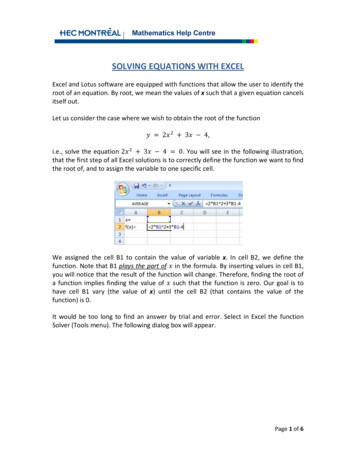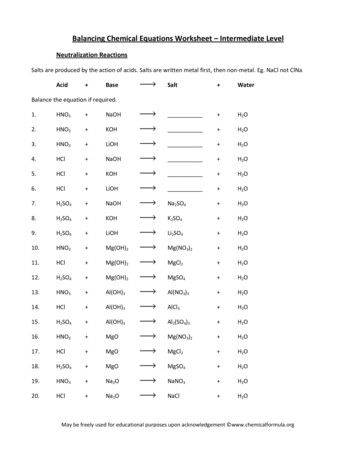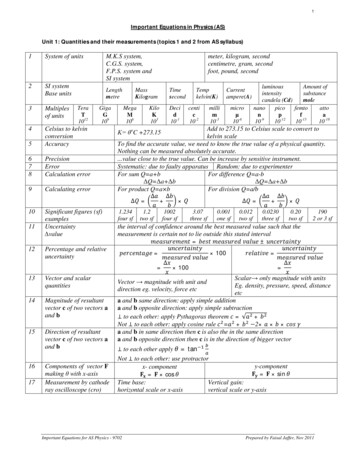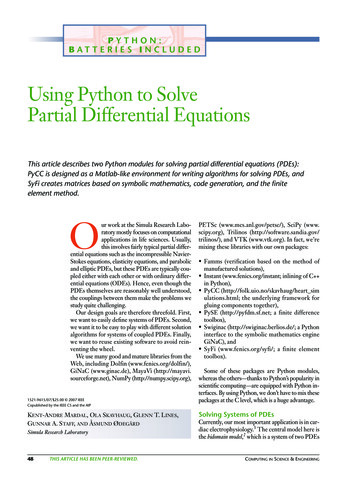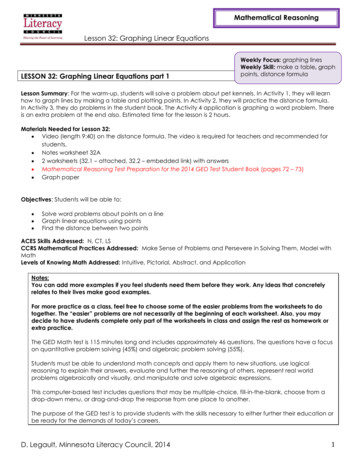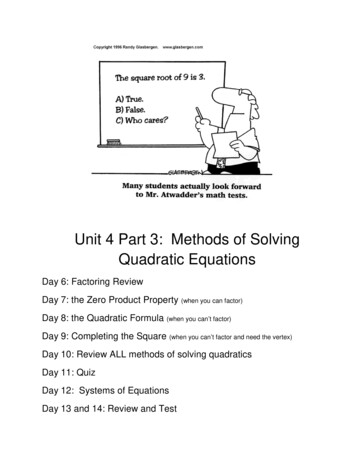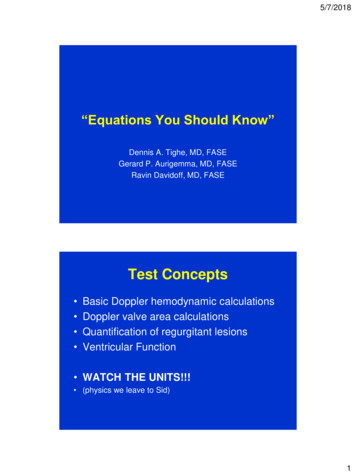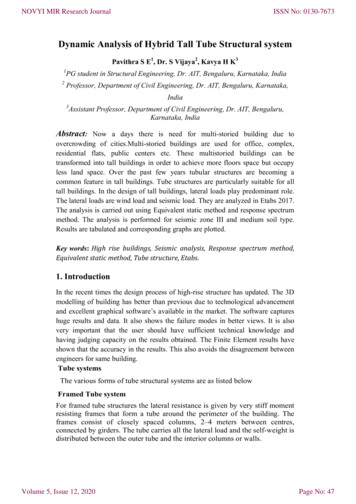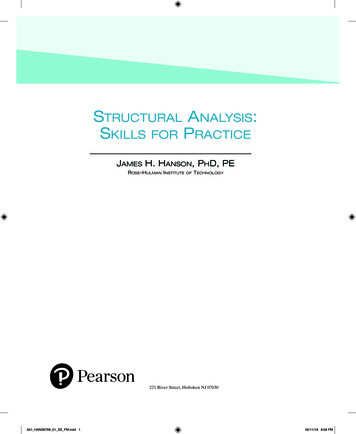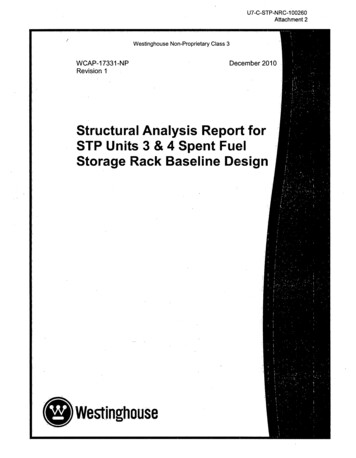
Transcription
CHAPTER 9Structural Analysis EquationsDouglas R. Rammer, Research General EngineerContentsDeformation Equations 9–1Axial Load 9–1Bending 9–1Combined Bending and Axial Load 9–3Torsion 9–4Stress Equations 9–4Axial Load 9–4Bending 9–4Combined Bending and Axial Load 9–6Torsion 9–7Stability Equations 9–7Axial Compression 9–7Bending 9–8Interaction of Buckling Modes 9–9Literature Cited 9–10Additional References 9–10Equations for deformation and stress, which are the basisfor tension members and beam and column design, are discussed in this chapter. The first two sections cover taperedmembers, straight members, and special considerations suchas notches, slits, and size effect. A third section presentsstability criteria for members subject to buckling and formembers subject to special conditions.Note that this chapter focuses primarily on presenting fundamental mechanics-based equations. For design procedures,the reader is encouraged to contact appropriate industrytrade associations or product manufacturers. Current designinformation can be readily obtained form their web sites,technical handbooks, and bulletins.Deformation EquationsEquations for deformation of wood members are presentedas functions of applied loads, moduli of elasticity and rigidity, and member dimensions. They may be solved to determine minimum required cross-sectional dimensions to meetdeformation limitations imposed in design. Average moduliof elasticity and rigidity are given in Chapter 5. Consideration must be given to variability in material properties anduncertainties in applied loads to control reliability of thedesign.Axial LoadThe deformation of an axially loaded member is not usuallyan important design consideration. More important considerations will be presented in later sections dealing withcombined loads or stability. Axial load produces a change oflength given by(9–1)where d is change of length, L length, A cross-sectionalarea, E modulus of elasticity (EL when grain runs parallel tomember axis), and P axial force parallel to grain.BendingStraight Beam DeflectionThe deflection of straight beams that are elastically stressedand have a constant cross section throughout their length isgiven by(9–2)where d is deflection, W total beam load acting perpendicular to beam neutral axis, L beam span, kb and ks constants9–1
General Technical Report FPL–GTR–190Table 9–1. Values of kb and ks for several beam loadingsDeflection atkbksUniformly distributedBoth simply supportedBoth clampedMidspanMidspan5/3841/3841/81/8Concentrated at midspanBoth simply supportedBoth clampedMidspanMidspan1/481/1921/41/4Concentrated at outerquarter span pointsBoth simply supportedBoth simply supportedMidspan 11/768Load point 1/961/81/8Uniformly distributedCantilever, one free, one clampedFree end1/81/2Concentrated at free endCantilever, one free, one clampedFree end1/31LoadingBeam endsdependent upon beam loading, support conditions, andlocation of point whose deflection is to be calculated, I beammoment of inertia, A′ modified beam area, E beam modulusof elasticity (for beams having grain direction parallel totheir axis, E EL), and G beam shear modulus (for beamswith flat-grained vertical faces, G GLT, and for beams withedge-grained vertical faces, G GLR). Elastic propertyvalues are given in Tables 5–1 and 5–2 (Chap. 5). The firstterm on the right side of Equation (9–2) gives the bendingdeflection and the second term the shear deflection. Valuesof kb and ks for several cases of loading and support aregiven in Table 9–1.shear deflection Ds can be closely approximated byThe moment of inertia I of the beams is given byEffect of Notches and HolesThe deflection of beams is increased if reductions in crosssection dimensions occur, such as by holes or notches. Thedeflection of such beams can be determined by consideringthem of variable cross section along their length and appropriately solving the general differential equations of theelastic curves, EI(d 2 y/dx 2) M, to obtain deflection expressions or by the application of Castigliano’s theorem. (Theseprocedures are given in most texts on strength of materials.)for beam of rectangular cross section(9–3)for beam of circular cross sectionwhere b is beam width, h beam depth, and d beam diameter.The modified area A′ is given byfor beam of rectangular cross section(9–4)for beam of circular cross sectionIf the beam has initial deformations such as bow (lateralbend) or twist, these deformations will be increased by thebending loads. It may be necessary to provide lateral or torsional restraints to hold such members in line. (See Interaction of Buckling Modes section.)Tapered Beam DeflectionFigures 9–1 and 9–2 are useful in the design of taperedbeams. The ordinates are based on design criteria such asspan, loading, difference in beam height (hc - h0) as requiredby roof slope or architectural effect, and maximum allowable deflection, together with material properties. From this,the value of the abscissa can be determined and the smallestbeam depth h0 can be calculated for comparison with thatgiven by the design criteria. Conversely, the deflection of abeam can be calculated if the value of the abscissa is known.Tapered beams deflect as a result of shear deflection in addition to bending deflections (Figs. 9–1 and 9–2), and this9–2for uniformly distributed load(9–5)for midspan-concentrated loadThe final beam design should consider the total deflectionas the sum of the shear and bending deflection, and it maybe necessary to iterate to arrive at final beam dimensions.Equations (9–5) are applicable to either single-tapered ordouble-tapered beams. As with straight beams, lateral ortorsional restraint may be necessary.Effect of Time: Creep DeflectionsIn addition to the elastic deflections previously discussed,wood beams usually sag in time; that is, the deflection increases beyond what it was immediately after the load wasfirst applied. (See the discussion of creep in Time underLoad in Chap. 5.)Green timbers, in particular, will sag if allowed to dry under load, although partially dried material will also sag tosome extent. In thoroughly dried beams, small changes indeflection occur with changes in moisture content but withlittle permanent increase in deflection. If deflection underlongtime load with initially green timber is to be limited,it has been customary to design for an initial deflection ofabout half the value permitted for longtime deflection. Ifdeflection under longtime load with initially dry timber is tobe limited, it has been customary to design for an initial deflection of about two-thirds the value permitted for longtimedeflection.Water PondingPonding of water on roofs already deflected by other loadscan cause large increases in deflection. The total short-term
Chapter 9 Structural Analysis EquationsFigure 9–1. Graph for determining tapered beamsize based on deflection under uniformly distributed load.deflection D due to design load plus ponded water can beclosely estimated by(9–6)where D 0 is deflection due to design load alone, S beamspacing, and Scr critical beam spacing (Eq. (9–31)).Combined Bending and Axial LoadConcentric LoadAddition of a concentric axial load to a beam under loadsacting perpendicular to the beam neutral axis causes increase in bending deflection for added axial compressionand decrease in bending deflection for added axial tension.The deflection under combined loading at midspan for pinended members can be estimated closely by(9–7)where the plus sign is chosen if the axial load is tensionand the minus sign if the axial load is compression, D ismidspan deflection under combined loading, D 0 beammidspan deflection without axial load, P axial load, andFigure 9–2. Graph for determining tapered beamsize on deflection under concentrated midspanload.Pcr a constant equal to the buckling load of the beam underaxial compressive load only (see Axial Compression in Stability Equations section.) based on flexural rigidity about theneutral axis perpendicular to the direction of bending loads.This constant appears regardless of whether P is tension orcompression. If P is compression, it must be less than Pcrto avoid collapse. When the axial load is tension, it is conservative to ignore the P/Pcr term. (If the beam is not supported against lateral deflection, its buckling load should bechecked using Eq. (9–35).)Eccentric LoadIf an axial load is eccentrically applied to a pin-ended member, it will induce bending deflections and change in lengthgiven by Equation (9–1). Equation (9–7) can be applied tofind the bending deflection by writing the equation in theform(9–8)where δb is the induced bending deflection at midspanand ε0 the eccentricity of P from the centroid of thecross section.9–3
General Technical Report FPL–GTR–190where ft is tensile stress, P axial load, and A cross-sectionalarea.Short-Block Compressive StressEquation (9–12) can also be used in compression if themember is short enough to fail by simple crushing withoutdeflecting laterally. Such fiber crushing produces a local“wrinkle” caused by microstructural instability. The memberas a whole remains structurally stable and able to bear load.BendingFigure 9–3. Coefficient φ for determining torsionalrigidity of rectangular member (Eq. (9 –11)).TorsionThe angle of twist of wood members about the longitudinalaxis can be computed by(9–9)where q is angle of twist in radians, T applied torque, Lmember length, G shear modulus (use, or approximate G by EL/16 if measured G is not available), and K across-section shape factor. For a circular cross section, K isthe polar moment of inertia:(9–10)where D is diameter. For a rectangular cross section,(9–11)where h is larger cross-section dimension, b is smaller crosssection dimension, and j is given in Figure 9–3.Stress EquationsThe equations presented here are limited by the assumptionthat stress and strain are directly proportional (Hooke’s law)and by the fact that local stresses in the vicinity of points ofsupport or points of load application are correct only to theextent of being statically equivalent to the true stress distribution (St. Venant’s principle). Local stress concentrationsmust be separately accounted for if they are to be limited indesign.Axial LoadTensile StressConcentric axial load (along the line joining the centroids ofthe cross sections) produces a uniform stress:(9–12)9–4The strength of beams is determined by flexural stressescaused by bending moment, shear stresses caused by shearload, and compression across the grain at the end bearingsand load points.Straight Beam StressesThe stress due to bending moment for a simply supportedpin-ended beam is a maximum at the top and bottom edges.The concave edge is compressed, and the convex edge isunder tension. The maximum stress is given by(9–13)where fb is bending stress, M bending moment, and Z beamsection modulus (for a rectangular cross section, Z bh2/6;for a circular cross section, Z pD3/32).This equation is also used beyond the limits of Hooke’slaw with M as the ultimate moment at failure. The resultingpseudo-stress is called the “modulus of rupture,” values ofwhich are tabulated in Chapter 5. The modulus of rupturehas been found to decrease with increasing size of member.(See Size Effect section.)The shear stress due to bending is a maximum at the centroidal axis of the beam, where the bending stress happens to bezero. (This statement is not true if the beam is tapered—seefollowing section.) In wood beams this shear stress mayproduce a failure crack near mid-depth running along theaxis of the member. Unless the beam is sufficiently shortand deep, it will fail in bending before shear failure candevelop; but wood beams are relatively weak in shear, andshear strength can sometimes govern a design. The maximum shear stress isfs kVA(9–14)where f s is shear stress, V vertical shear force on cross section, A cross-sectional area, and k 3/2 for a rectangularcross section or k 4/3 for a circular cross section.Tapered Beam StressesFor beams of constant width that taper in depth at a slopeless than 25 , the bending stress can be obtained from Equation (9–13) with an error of less than 5%. The shear stress,however, differs markedly from that found in uniformbeams. It can be determined from the basic theory presented
Chapter 9 Structural Analysis EquationsFigure 9–4. Shear stress distribution for a tapered beam.by Maki and Kuenzi (1965). The shear stress at the taperededge can reach a maximum value as great as that at the neutral axis at a reaction.Consider the example shown in Figure 9–4, in which concentrated loads farther to the right have produced a supportreaction V at the left end. In this case the maximum stressesoccur at the cross section that is double the depth of thebeam at the reaction. For other loadings, the location of thecross section with maximum shear stress at the tapered edgewill be different.For the beam depicted in Figure 9–4, the bending stress isalso a maximum at the same cross section where the shearstress is maximum at the tapered edge. This stress situationalso causes a stress in the direction perpendicular to theneutral axis that is maximum at the tapered edge. The effectof combined stresses at a point can be approximately accounted for by an interaction equation based on the Henky–von Mises theory of energy due to the change of shape. Thistheory applied by Norris (1950) to wood results inf x2Fx2 2f xyxy2Fxyxy f y2Fy2 1(9–15)where fx is bending stress, fy stress perpendicular to the neutral axis, and fxy shear stress. Values of Fx, Fy, and Fxy arecorresponding stresses chosen at design values or maximumvalues in accordance with allowable or maximum valuesbeing determined for the tapered beam. Maximum stressesin the beam depicted in Figure 9–4 are given by(9–16)Substitution of these equations into the interaction Equation(9–15) will result in an expression for the moment capacityM of the beam. If the taper is on the beam t
Chapter 9 Structural Analysis Equations deflection D due to design load plus ponded water can be closely estimated by (9–6) where D. 0. is deflection due to design load alone, S beam spacing, and S. cr. critical beam spacing (Eq. (9–31)). Combined Bending and Axial Load. Concentric Load Addition of a concentric axial load to a beam under loads acting perpendicular to the beam neutral axis .Cited by: 1Page Count: 12File Size: 1MBAuthor: Douglas R. Rammer

